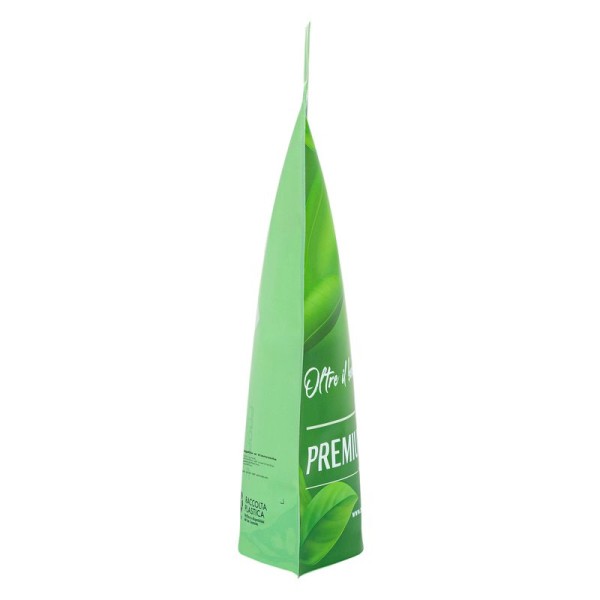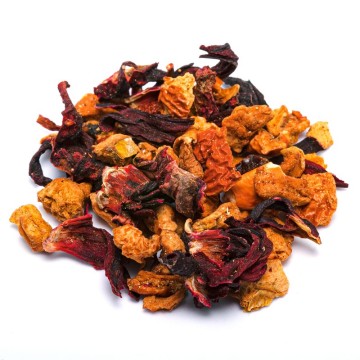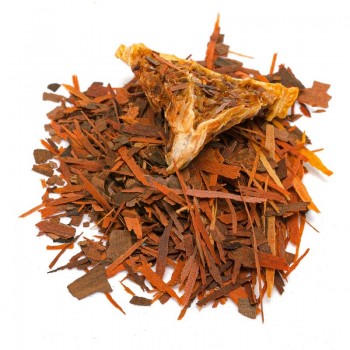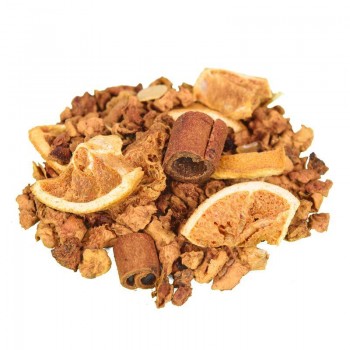Ginger vanilla and cinnamon infusion, description and properties:
The ginger, vanilla and cinnamon infusion envelops you with an unmistakable scent of spices and fruit. An aromatic and tasty natural remedy that is very useful in winter, thanks to its soothing properties for mucus and decongestant for the respiratory tract. The infusion is recommended as a drink at the end of a meal to aid digestion. Ginger, vanilla and cinnamon infusion It warms the heart and is good for the body: it is the perfect spicy infusion for the cold season, when the days get shorter and we need tranquility and support for our defenses.
This mixture gives different stimulating spices and fruits suited to the climate, with sweet and pungent notes at the same time, truly intriguing. A refined flavor that makes the infusion a refreshing and comforting drink, evoking the fragrant memories of autumn and Christmas - including cinnamon, vanilla, cloves, cardamom. The fruit notes with dates, figs and grapes support the taste with sweetness, up to the provocative ginger. In addition to an unmistakable aroma, this mixture also helps to defy the cold due to its properties. Ginger, vanilla and cinnamon infusion: properties and benefits By taking this infusion you obtain the benefits of the spices, with a combination already highly appreciated in Ayurvedic medicine and phytotherapy. The ginger, vanilla and cinnamon herbal tea has multiple qualities and contributes to well-being with useful support in the coldest period. It alleviates the symptoms of nose and throat irritation, typical of the common cold, by acting on mucus in a soothing and decongestant way. It promotes the fluidity of bronchial secretions, supported in particular by star anise, cardamom and dates. Cloves are combined with the balsamic effect and the fig for the functionality of the mucous membranes in the respiratory system.
The ability of ginger and other ingredients to calm irritations in the body represents a natural remedy against sore throats, headaches and joint pain. The spicy components promote digestion, helping to combat the feeling of heaviness after meals. The infusion, in fact, represents a pleasant drink to be enjoyed during the digestive process to stimulate the production of gastric juices and intestinal transit. Excellent at any time against abdominal swelling, the mixture has a carminative action and counteracts the formation of gas. The ginger element is useful for eliminating nausea from indigestion, while dates have an emollient and soothing action in the digestive system. While a pinch of vanilla helps relax and flavour, cinnamon and ginger, together with grapes, also promote correct blood circulation and the functionality of the cardiovascular system. The ingredients contain various antioxidants, which make the infusion suitable for counteracting the action of free radicals.
Origins and history of cultivation
Ginger as a spice comes from the rhizome (underground root) of the flowering plant, probably native to Asia or Southeast Asia. Its spicy aroma is due to the presence of substances (ketones, gingerols) now known for their properties as well as their taste. This spice dates back over 3,000 years, and we know that it was domesticated even back then: ginger does not grow in the wild and its origins are uncertain. The Indians and Chinese cultivated ginger as a root tonic. Exported from India to the Roman Empire more than 2000 years ago, it became a highly sought after spice in the following centuries too: Arab merchants controlled the trade in ginger and other spices for centuries, until today's spread on a global scale. It is grown in all humid tropical climates, with India being the largest producer.
Vanilla originates from South America, from a Central American orchid that is widespread in Mexico. The aroma is extracted from the pods of the plant: inside there are black seeds soaked in a very fragrant dark oil. The most odorous ones are the pods covered in vanillin, the natural aromatic substance present in the form of white crystals.
Vanilla has been used for centuries by the Aztecs to flavor cocoa through ground vanilla, as a perfume and aphrodisiac. Until the mid-nineteenth century, Mexico retained a monopoly on vanilla production, while today the plant is also cultivated elsewhere or created synthetically. Even today, vanilla is the second most expensive spice in the world after saffron.
Natively from Ceylon (Sri Lanka), cinnamon comes from the bark of a plant that grows in that territory. It was known, however, already in Chinese writings in 2800 BC. and over time it spread to other territories toogolds. Its botanical name Cinnamomum derives from the Hebrew and Arabic term amomon, which means fragrant spice plant. It was used by the ancient Egyptians in the embalming process, and by the Romans who considered it precious. It was known in the Middle Ages to treat coughs and sore throats, as well as to preserve meat (phenol antioxidants inhibit spoilage bacteria). Ceylon then became a monopoly of foreign powers who took over the island and its production. Today cinnamon is also cultivated in South America, the West Indies and other areas with a tropical climate.
Fruits and spices
Vanilla comes from the Vanilla planifolia plant, which belongs to the Orchidaceae family. It is a climbing plant that produces large yellow-green flowers. The long narrow pods, which contain small seeds, provide the aroma. There are various types of orchids, and the infusion contains Bourbon Vanilla which grows in Madagascar and on Reunion Island (formerly Bourbon Island).
The cinnamon tree is Cinnamomum zeylanicum (Ceylon cinnamon) of the Lauraceae family. It has a bark with high aromatic properties, and reaches about 15 meters in height. It grows in moist, well-drained soil, producing small greenish-yellow flowers and a dark drupe like fruit. Among related species, Chinese cassia (Cinnamomum cassia), Vietnamese (C. loureiroi), Indonesian (C. burmannii), and Malabar (C. citriodorum) are cultivated as a source of the spice.
Ginger is the spice that comes from the rhizome (root) of the herbaceous plant Zingiber officinalis. It grows for about a meter, developing the underground rhizome and shoots from which the flowers with pale yellow petals arise. Ginger plants are tropical, preferring high humidity and high temperatures, growing best in moist, rich soil.
The date palm is the Phoenix dactylifera plant, of the Arecaceae (Palmae) family. Its roots develop deep, to recover water in arid soils. Reaching heights of up to 30 meters and gives its berries (dates) with different sizes and colors depending on the varieties.
Cloves are the dried flower buds of the Eugenia caryophyllata (or Syzygium aromaticum) plant. Belonging to the Myrtaceae family, it is native to Indonesia. Cloves as a spice have nothing to do with the clove plant.
Cardamom derives from the tropical plant Elettaria Cardamomum, of the Zingiberaceae family. The pod or capsule contains several seeds, small and dark, which give the aroma. There are also black cardamom (Amonum Subulatum), brown-brown and white cardamom.
Star anise comes from the dried fruits of the Illicium verum tree native to Asia. It gives a fruit similar to that of anise (Pimpinella anisum), with which it has no relation. The fruit gets its name from the star shape of its carpels (modified leaves) - each contains one seed.
The grape comes from the Vitis vinifera plant, belonging to the Vitaceae family. It is a climber that can easily cover walls and surfaces. It displays large leaves and tiny green flowers. The famous fruits are globose clusters, different depending on the variety of the vine.
The common fig plant (Ficus carica) belongs to the Moraceae family. It shows a short stem with large, lobed leaves. Figs usually thrive in areas with long, hot summers. The fruits which are actually a fleshy infructescence, rich in sugars and of variable colour.
Nutritional values of ginger, vanilla and cinnamon infusion
The main active ingredients are the antioxidants (flavonoid polyphenols) contained in the various components, and various mineral salts. Compounds such as gingerols and shogaols, eugenol, vanillin, cinnamaldehyde, organic acids are present. How to prepare the infusion properly
The infusion is obtained by placing approximately 3-5 grams of the ginger, vanilla and cinnamon mixture in a cup (250 ml), with water at 100 °C.
Leave to infuse for 10 to 12 minutes before drinking. Add honey or sugar, if desired.
Ginger vanilla and cinnamon infusion: side effects and contraindications
To avoid unwanted effects it is necessary to respect the recommended doses and not exceed the consumption of the infusion. Excessive intake can cause diarrhea, gastrointestinal disorders, headaches.











 No reward points for this product.
No reward points for this product.










![infuso lime mirtilli rossi [Natura d'Oriente]](https://www.naturadoriente.com/3551-home_default/lime-infused-cranberries.jpg)




